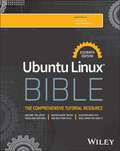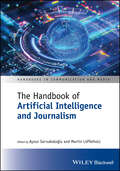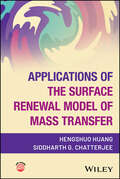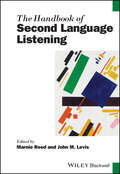- Table View
- List View
Enchanted Islands: A Mediterranean Odyssey – A Memoir of Travels through Love, Grief and Mythology
by Laura Coffey"A magical and hugely captivating journey - filled with such beauty, wonder and surprise. A simply marvellous read, hugely recommended" - Stephen Fry A real-life journey through the fantastical world of The OdysseyIt started with a boy, of course. Seeking solace from the pain of heartbreak and her father's illness, Laura Coffey embarks on what was meant to be a simple holiday. But her newfound fascination with ancient Greek myths transforms her trip into a six-month odyssey, around tiny archipelagos and mystical Mediterranean islands thought to be the setting of Odysseus's epic journey. As she chases one of the most conflicted, flawed and yet beloved heroes through his fantastical sea-kingdoms, looking for the places where geography and mythology collide, she discovers the wild beauty of the islands, and the redemptive powers of travel and nature, cold-water swimming, long hikes up mountains, and luminous star-lit skies.But her quest to find happiness, safety and the true meaning of home is overshadowed by the deepening illness of her father. Returning as he's dying, forced to confront the very things she was running from, Laura reflects on what she has lost, how to live between story and reality, and the way we craft our own mythologies. Slipping between the mythical realm and the real world, she finds enchantment and healing in the magic of both."If you love memoir and Greek mythology, this is a delight. A spellbinding book about growing up, grieving and the gods." - Clare Pollard, author of Delphi
Brimstone: sequel to the addictive enemies-to-lovers romantasy global sensation QUICKSILVER (Fae & Alchemy)
by Callie HartDON'T MISS OUT ON THE SERIES THAT EVERYONE IS TALKING ABOUTPrepare for the breath-taking sequel to the runaway bestseller and global phenomenon Quicksilver from Sunday Times and New York Times bestselling author Callie Hart.Duty. Blood. Honour. Power.Saeris Fane doesn't want power. The very last thing she needs is her name whispered on an entire court's lips, but now that she's been crowned queen of the Blood Court, she's discovering that a queen's life is not her own. A heavy weight rests upon her shoulders.Her ward - and her brother - need her back in her homeland . . . but the changes that have strengthened Saeris have also made her weak. Born under blazing suns, Saeris will surely die if she makes her way home through the Quicksilver. Which means that, once again, she must send someone else in her stead . . .'Keep your mouth shut. Stick to the shadows. And for the love of all seven Gods, do NOT crack any jokes.' Kingfisher of the Ajun Gate has defeated armies and survived all manner of horrors, but traveling back to Zilvaren with Carrion Swift might just be the death of him. The male just will not shut up. Hidden dangers await them down the narrow alleyways of the Silver City. Unfolding secrets pose impossible threats. Fisher must wrangle the smuggler and accomplish his goals quickly if he wants to see his mate again. A darkness falls across Yvelia. The realm and their friends are in danger. Together, Saeris and Fisher will pass through fire and brimstone to save them.
The Widow: the unforgettable new courtroom drama from the master of the legal thriller!
by John Grisham'A classic, compulsive, taut and thrilling novel from one of the great storytellers of our time. No one does it better' CHRIS WHITAKERSHE NEEDS A LAWYER. HE NEEDS A PAYDAY.Lawyer Simon Latch is struggling with debt, gambling issues and an impending divorce. But when Eleanor Barnett, an 85-year-old widow, visits his office to secure a new will, it seems his luck has finally changed: she claims she's sitting on a $20 million fortune and no one else knows about it.Once he's hooked the richest client of his career, Simon works quietly to keep her wealth under the radar. But it's a terrible mistake. Hidden secrets have a way of being found out, and when Eleanor is hospitalised after a car accident, Simon realises that nothing is as it seems.As events spiral out of control, he finds himself on trial for a crime he swears he didn't commit: murder.The Widow is classic Grisham courtroom drama combined with a confounding murder mystery that will enthral his legion of fans. 💥350+ million copies, 45 languages, 10 blockbuster films: JOHN GRISHAM IS THE MASTER OF THE LEGAL THRILLER💥
How to Romanticize Your Life: Joyful Tips and Advice to Elevate Every Day
by Sophie GoldingMake everyday moments delightfully dazzling and appreciate simple pleasures with this uplifting guide to romanticizing your lifeSometimes the most magical things in life are the simplest: a good book, the soft pitter-patter of rain, the feel of grass beneath bare feet. If we could fill our lives with these small pleasures and find ways to make even the most mundane activities feel special and exciting, just think how lovely our worlds could be.Learn how to elevate your everyday with this stunning guide to finding joy in everything you do. "Romanticizing your life" doesn't mean living a flashy lifestyle or spending like a superstar; it simply means taking small steps to make even the most ordinary day feel extraordinary.This book is filled with fun and easy ideas to add sparkle to your daily routine, including:- Using your fanciest dinnerware to make all meals feel like special occasions- Infusing your glass of water with delicious fruits and flavours - Listening to mood-boosting music to transform daily tasks and chores And much more! With the help of this book, you'll soon be on the path to a life that's filled with gratitude, self-kindness, and simple, magical moments.
The Romans: A 2,000-Year History
by Edward J. Watts'At last, a history of the Roman state as it has always been crying out to be told, and never has been!' RODERICK BEATONThe greatest empire in Western history - told as never been told before.Rome is often remembered for its spectacular collapse. But for over two thousand years - through civil wars, plagues, invasions, and religious upheaval - the Roman state survived, adapted, and reinvented itself. From a muddy settlement on the banks of the Tiber to the glittering court of Constantinople, this is the untold story of a civilisation that endured.In The Romans, acclaimed historian Edward J. Watts tells the first truly complete history of Rome in all its epic sweep: the Punic Wars, the fall of the republic, the coming of Christianity, Alaric's sack of Rome, the rise of Islam and the onslaught of the Crusaders who would bring about the empire's end. This is the Rome of Augustus, Marcus Aurelius, and Constantine. But it is also the Rome of Charlemagne, Justinian, and Manuel Comnenus, and countless diverse men and women who shaped the empire: African emperors, Byzantine intellectuals and ordinary citizens whose loyalty together made it the most resilient state the world has ever seen.An expansive, eye-opening portrait, this is the definitive history of Rome and its citizens.
365 Amazing True Football Stories: One for every day! (Unbelievable Football #6)
by Matt Oldfield**365 Amazing TRUE football stories - one for every day of the year! The perfect gift for football mad readers**Think you know everything about football?Have you heard of...* The clever Chilean forward who invented the bicycle kick?* The longest penalty shootout in history?* The dream debut from superstar striker, Lamine Yamal?* The player who got a haircut in the middle of the game?* The day Ada Hegerberg made history and was named the best women's player in the world?From incredible heroes and amazing matches, to the founding of legendary clubs and the most momentous moments in footballing history, this book is packed full of true stories for every single day of the year.From January 1st to December 31st, there's a football story to discover. Mega football fans can take it one day at a time, dip in and out, or skip ahead to whichever day they choose.The next unbeatable book for football-mad kids and reluctant readers in the award-winning series, Unbelievable Football.
Remain: A supernatural love story from the globally bestselling author of love stories like The Notebook and the renowned writer and director of blockbuster thrillers like The Sixth Sense
by Nicholas Sparks M. Night Shyamalan*COMING SOON AS A MAJOR MOTION PICTURE DIRECTED BY M. NIGHT SHYAMALAN AND STARRING JAKE GYLLENHAAL AND PHOEBE DYNEVOR*'You're going to fall in love, Tate. And when you do, it's going to change your life forever...'When New York architect Tate Donovan arrives in Cape Cod to design his best friend's summer home, he is hoping to make a fresh start. Recently discharged from an upscale psychiatric facility where he was treated for acute depression, he is still wrestling with the pain of losing his beloved sister. Sylvia's deathbed revelation - that she can see spirits who are still tethered to the living world, a gift that runs in their family - sits uneasily with Tate, who struggles to believe in more than what reason can explain. But when he takes up residence at a historic bed-and-breakfast on the Cape, he encounters a beautiful young woman named Wren who will challenge every assumption he has about his logical and controlled world.Tate and Wren find themselves forging an immediate connection, one that neither has ever experienced before. But Tate gradually discovers that below the surface of Wren's idyllic small-town life, hatred, jealousy and greed are festering, threatening their fragile relationship just as it begins to blossom. Tate realizes that in order to free Wren from an increasingly desperate fate, he will need to unearth the truth about her past before time runs out . . . a quest that will make him doubt whether we can ever believe the stories we tell about ourselves, and the laws that govern our existence. Love - while transformative - can sometimes be frightening.A story about the power of transcendent emotion, Remain asks us all: Can love set us free not only from our greatest sorrows, but even from the boundaries of life and death?A one-of-a-kind novel that grapples with the supernatural mysteries of life, death, and human connection - an unprecedented collaboration between the globally bestselling author of love stories like The Notebook and the renowned writer and director of blockbuster thrillers like The Sixth Sense.Real readers love Remain:'[This epic love story is] often creepy but always engaging. I raced through it' Daily Mail'Love, spirits and sinister secrets converge in this unusual, genre-blurring collaboration between two masters of emotional and eerie storytelling' I paper'A warm-hearted, sentimental tale' Guardian'Tender and unsettling, a novel that lingers like a haunting' The Weekend Australian'Nicholas Sparks with his signature love story combined with M. Night Shyamalan's suspense brought about a unique combination. This is one of those books you don't want to put down but you also want to savor' GoodReads reviewer ⭐⭐⭐⭐⭐'The mix of genres (romance, whodunnit mystery, and slight horror) make this book a five-star read! Remain is a haunting, emotional, and unforgettable read. Highly recommend' GoodReads reviewer ⭐⭐⭐⭐⭐'An absolutely captivating story! It had romance, suspense, paranormal, mystery, small town vibes, and healing...a perfect October book...I didn't want to put it down!' GoodReads reviewer ⭐⭐⭐⭐⭐'I LOVED this romance, but it also had so many other elements that kept me hooked. The mystery and paranormal aspects were chef's kiss, and I felt like I was watching a movie while reading this one' GoodReads reviewer ⭐⭐⭐⭐⭐
The Tech Exit: A Practical Guide to Freeing Kids and Teens from Smartphones
by Clare MorellIt's no secret that addictive digital technologies like smartphones and social media apps are harming a generation of kids socially, mentally, and even physically. But a workable solution seems elusive. After all, don't kids need phones, and won't they be vulnerable or socially isolated without tech?Clare Morell, fellow at the Ethics and Public Policy Center and director of its Technology and Human Flourishing Project, argues that the answer is 'no'. She exposes the lies parents have been sold about managing the dangers of tech through parental controls and screen-time limits, and demonstrates that another way is possible - even if your children are already using smartphones or social media.The Tech Exit maps a doable pathway to freedom from digital technology for families, local communities, and society. Drawing on dozens of interviews with experts and with families who have gone tech-free, as well as Morell's own work as a policy expert, The Tech Exit shows how digital technology is anything but necessary for children to live happy, healthy, and socially full lives.The Tech Exit is essential reading for any parent who has felt stuck between an awareness of the dangers of digital technology for kids and the feeling that tech is necessary and inevitable. Clare Morell's message is simple and compelling: You and your family can be free. The life you want for your children is within reach.
The Game-Players of Titan
by Philip K DickThe creatures from Saturn's moon Titan could appear human or inhuman at will. And the elaborate contest they set up with the remnants of Earth's humanity was just as treacherous. Pete Garden was one of the finest game-players this side of Titan - but was he good enough? For although the war had been fought to a stalemate, the unending series of gambles could upset the truce - and end the world.
You Do You: Quotes to Uplift, Empower and Inspire
by Summersdale PublishersNo one is better at being you than you... and there's only one you in the universeHere's to the often-imitated, never bettered, wonderfully unique you! These inspirational quotes and uplifting mantras will remind you that you don't need to follow the crowd - follow your heart and keep on being your amazing, individual self.Filled with memorable quotes from a variety of bright and brilliant figures, this book will help you change your mindset and set your life on a new pathway towards self-love, self-confidence and high self-esteem. You can use the wise words within to:- Redefine what it is you want out of life- Recognize your integral worth- Reimagine your place in the world- Remind yourself that you are specialYou deserve to love yourself for who you are! So, what are you waiting for? Spend your days being happy, confident and true to yourself with this exciting and empowering book.
The Faithfuls: A 100% Unfaithful Parody of The Traitors
by Huw DunnitINNOCENT BUT ANNOYING STRANGERS ARE BEING MURDERED ONE BY ONEWelcome to a medieval castle in the wilds of Scotland. Arriving here are contestants in the world's most popular new TV Reality show: two dozen ordinary (and painstakingly diverse) individuals from every corner of the British Isles. These seemingly random individuals random represent a cross-section of society (although shallow nobheads seem to be a bit over-represented). The castle is vast and labyrinthine, as are the paths through this treacherous landscape ...The Faithfuls are ready to make friends, stab each other's backs, and possibly win huge sums of money and even become famous into the bargain. Imagine a hen party Murder Mystery Weekend with Harry Potter cosplay. Pitted against each other, these law-abiding folk find their values challenged. Relationships are tainted by distrust and fear. Betrayal, hate and bad faith take the upper hand as the rules that hold society together rapidly start to crumble. And this is when they are denied access to social media. Each night one of the group is 'murdered' by the dark, secretive forces within - the Traitors. Their actions are directed by the sinister Manny Clawdwinkle whose remarkable wardrobe (one might suppose) is large enough to fill every room in the castle. Will the murderous Traitor be unearthed before the Faithfuls finally rip each other to shreds? And do that many people in society really have so much cosmetic surgery? Phew!
Ubuntu Linux Bible
by Christopher Negus David ClintonThe latest version of the gold standard in Ubuntu Linux resources In the freshly updated eleventh edition of Ubuntu Linux Bible, a team of veteran Linux educators delivers a comprehensive discussion of the Ubuntu Linux operating system. Perfect for absolute beginners and experienced users and server admins alike, this book explains the ins-and-outs of installing, configuring, maintaining, optimizing, and using Ubuntu systems. This edition builds on the user-centric approach used by previous editions, showing you exactly how to perform common and essential tasks, like interfacing with popular IoT devices. The book covers: Becoming a Linux power user: Using the Shell, navigating the filesystem, and more Installing and configuring an Ubuntu Linux desktop or server Linux server administration, including managing remote access and common desktop network configuration settings Linux security techniques, including cryptography, PAM, and AppArmor The Ubuntu Linux Bible is intuitively organized, allowing you to skip quickly to the section you need in the moment. It also covers the latest version of the popular Linux distribution – v24.04 at the time of writing – as well as the previous version. You'll also find: Complete coverage of the enterprise and network functionality offered by Ubuntu, like web servers, networked file sharing, and DHCP and DNS management Up-to-date explanations of desktop Ubuntu configuration, including user management, system backups, printer and device management, and wireless features End-of-chapter exercises and questions, complete with answers, to help you develop your hands-on Ubuntu skillset Perfect for Ubuntu Linux beginners and novice users, Ubuntu Linux Bible is also an essential resource for anyone transitioning from Windows desktops and servers looking for concise, accurate, and expert guidance in the Ubuntu OS.
The Handbook of Artificial Intelligence and Journalism (Handbooks in Communication and Media)
by Martin Löffelholz Aynur SarısakaloğluPresents a comprehensive global overview of AI-driven journalism and its transformative impact on media practices As artificial intelligence (AI) continues to reshape the media landscape, The Handbook of Artificial Intelligence and Journalism provides the first comprehensive academic exploration of the intersection between AI technologies and journalism. Edited by Aynur Sarisakaloglu and Martin Löffelholz, this foundational volume brings together 37 leading scholars from six continents to examine how AI is redefining the structures, practices, and epistemologies of journalism. Organized around key thematic areas, the Handbook investigates the driving forces propelling the algorithmic transformation and unveils emerging trends in journalistic practice and journalism research, moving beyond Western-centric perspectives to incorporate diverse global experiences and knowledge production. Twenty-eight original chapters address systemic shifts such as evolving structures of media organizations, changing roles of actors, transformations in news production routines, and shifting patterns of news consumption. By integrating theoretical, empirical, and practical perspectives, the Handbook sets the stage for a new research agenda for understanding AI-driven journalism on a global scale. Containing rigorous interdisciplinary scholarship and broad geographical coverage, The Handbook of Artificial Intelligence and Journalism: Integrates theoretical foundations, empirical studies, and practical applications in a cohesive structure Offers insights into journalism practices across a wide range of geographical contexts and engages with approaches that transcends Western-dominated paradigms, incorporating perspectives from the Global South Employs interdisciplinary frameworks to enhance the understanding of AI-driven journalism Examines the sociotechnical dynamics of AI, including its potential benefits and challenges for journalism Presents forward-looking reflections on the future of journalism research in the AI era The Handbook of Artificial Intelligence and Journalism is ideal for undergraduate, graduate, and doctoral students in journalism, communication, and media studies programs. It also serves as a vital reference for researchers, educators, media professionals, and policy advisors engaged in digital journalism, journalism research, media innovation, and public communication.
Applications of the Surface Renewal Model of Mass Transfer
by Hengshuo Huang Siddharth G. ChatterjeeIntroduction to the surface renewal model of mass transfer for the analysis and design of gas-liquid contacting equipment and membrane filters Applications of the Surface Renewal Model of Mass Transfer provides a rigorous application of the surface renewal theory of mass transfer to describe physical and chemical gas absorption and membrane filtration. This book demonstrates that the surface renewal model can predict the experimentally measured liquid-side physical mass-transfer coefficient in gas absorption with a fair degree of accuracy, shows that the surface renewal model can correlate permeate flux and transmembrane pressure drop data in constant pressure and constant flux microfiltration, and contains numerous examples of the application of the model to real-world situations. This book includes information on: Applications of the surface renewal model in fields like chemical engineering and oceanography The complex nature of the surface renewal model as a better description of the turbulent hydrodynamics that prevail at the gas-liquid interface compared to the film model Measurements of the liquid-side physical mass-transfer coefficient in gas absorption studies and surface-age distributions in wind-wave tanks Flow instabilities induced by wall roughness or spacers or by their deliberate introduction into the main flow in membrane filtration Analysis and design of gas-liquid contactors (stirred tanks and packed towers) and membrane filters using a mass-transfer approach Applications of the Surface Renewal Model of Mass Transfer is an excellent, first-of-its-kind reference for researchers in academia and industry, along with advanced students in chemical engineering, environmental engineering, bioprocess/biological engineering, paper engineering, and related programs of study.
Veterinary Necropsy Guide
by Teresa Southard Sean McDonoughAn updated and expanded guide to performing necropsies on veterinary patients, now covering farm animals and exotics in addition to dogs, cats, and small mammals Veterinary Necropsy Guide, Second Edition delivers practical guidance on how to perform a postmortem examination in animals. The book includes expanded and updated species coverage, now including cattle, horses, sheep, goats, alpacas, llamas, pigs, and exotics, in addition to dogs, cats, and small mammals. It offers detailed descriptions of the necropsy procedure in small animals, comparative anatomy, modified procedures appropriate for various species, and special postmortem species. Each chapter covers an organ system and explains dissection, examination, and tissue collection. The authors also include guidelines for sample collection for ancillary testing. Veterinary Necropsy Guide provides: A thorough introduction to veterinary necropsy, including when, how, and why to perform a postmortem examinationComprehensive explorations of canine, feline, small mammal, farm animal, and exotic animal necropsiesPractical discussions of comparative anatomy, procedural modifications, and special necropsy techniquesComplete treatments of the necropsy procedure, organ systems, and additional testing Veterinary Necropsy Guide is an essential reference for veterinary students, veterinary anatomic pathology residents, and veterinary pathologists, laboratory veterinarians, shelter veterinarians, and veterinary practitioners who perform necropsies.
The Handbook of Second Language Listening (Blackwell Handbooks in Linguistics)
by John M. Levis Marnie ReedEssential insights and strategies for teaching and researching second language listening comprehension skills The Handbook of Second Language Listening provides comprehensive and authoritative coverage of the processes, challenges, and pedagogy of second language (L2) listening. Designed for researchers, teacher educators, and classroom practitioners, this volume presents a systematic examination of how L2 learners perceive and interpret spoken language across diverse contexts and discusses how instruction can better support the listening process. The Handbook addresses a broad range of topics essential to understanding and teaching L2 listening, including perceptual foundations, the influence of prosody, speech perception, listening assessment, and metacognitive strategy use. Chapters by leading scholars and emerging voices in applied linguistics bridge theory and practice by offering evidence-based insights into listener variability, instructional design, and the interface between listening and pronunciation. This book brings attention to topic areas often overlooked, such as decolonial theory in listening research and the impact of orthography on perception. Equipping educators and scholars with the tools needed to understand L2 listening as both a cognitive process and a teachable skill, the Handbook of Second Language Listening: Integrates current findings from phonetics, psycholinguistics, and applied linguistics Connects theoretical models of perception and processing with classroom-based applications Addresses foundational and emerging topics, from phonetic decoding comprehension of spoken academic discourse Includes dedicated sections on technology-enhanced assessment and instruction Covers key pedagogical challenges such as listening in noise, processing of prosody, and strategy instruction Provides practical frameworks for evaluating and designing L2 listening tasks The Handbook of Second Language Listening is ideal for graduate-level courses in TESOL and Applied Linguistics, including Second Language Acquisition, Listening Pedagogy, and Language Assessment, which are core to MA TESOL and Linguistics programs. It is also a critical reference for researchers, teacher educators, curriculum designers, and language assessment specialists.
A Little Holiday Fling
by Farah HeronThe joy of Christmas and the thrill of falling in love collide in this gorgeous novel from the highly praised author of Accidentally Engaged.There are two things that Ruby Dhanji loves with her whole entire heart: Christmas and anything to do with the UK. For Ruby the holidays means joy and warm memories with her late mother. And now she's on the verge of realizing the dream she and her mom always had: moving to England and opening a cozy inn. The only problem, Ruby needs some hotel experience first. Rashid just doesn't get all the holiday hype. But when he meets a woman dragging home a Christmas tree alone he has to offer to help-even if he soon finds Ruby adores all the things he dislikes. When Ruby discovers that his family owns a luxury boutique hotel chain she offers him a proposition: she'll help him give his young nieces an amazing Christmas if he'll facilitate an introduction to his family. As Ruby and Rashid's friendship turns to something more, she's afraid she's falling for someone weeks before she moves across the Atlantic and she'll soon have to decide which dream she wants to chase.***Praise for Farah Heron 'Heron [writes] crackling banter' Entertainment Weekly 'Farah Heron writes with the keen eye of a satirist and the big heart of a romantic' Jenny Holiday 'Heron writes a compelling story . . . [that] will appeal to readers looking for complex family dramas and sumptuous descriptions of food and cooking' Kirkus 'Heron's sensitive insights infuse this romance with both immense charm and emotional depth' Booklist
Men's Football Legends 2026
by David BallheimerWho are currently the best players in world football? Is Mo Salah still the most prolific in front of goal or is Ousmane Dembele at PSG who's claiming the top spot? Which midfielder has the most impact on a game - Real's Jude Bellingham with his attacking play, or Barcelona's Pedri with his vision and passing? Who's the one to beat in between the sticks - is Alisson Becker still the world's premier keeper or has AC Milan's Maignan taken the top spot in 2026? While every fan has an opinion, back yours up with the latest stats featured in Football Legends 2026 (Men's) and show them who's the best football pundit! Showcasing the top 100 stars in the modern game, Football Legends 2026 offers the latest facts and stats of players in every position who play - or spent most of their careers - in Europe's elite leagues. With a star profile on each page, the book is packed with incisive data and includes stunning heat maps that show the pitch movements of every player featured. Get your copy now and start comparing the goals, assists, saves, freekicks (and a host of other data) of the current icons in world football.
When the Eagle Hunts (Eagles of the Empire #3)
by Simon ScarrowIF YOU DON'T KNOW SIMON SCARROW, YOU DON'T KNOW ROME!WHEN THE EAGLE HUNTS is the compelling third novel in Simon Scarrow's bestselling Eagles of the Empire series. For fans of Bernard Cornwell and Conn Iggulden. 'Scarrow's [novels] rank with the best' IndependentBritannia, AD 44. Cato, a thoughtful junior officer in the Roman army, and his commanding centurion, Macro, are simply pawns in Rome's lust to conquer Britain. During the freezing winter, the two men and their legion fight the native savages in hand-to-hand battles that haunt Cato for days after.But in a place full of enemies, the most vicious are the Druids of the Dark Moon; brutal, merciless men who have captured the wife and children of General Plautius himself.So Macro and Cato are given a mission: to travel deep into enemy territory and recover the hostages. If they fail, the fate of the Roman army may just hang in the balance...
Gallagher: The Fall and Rise of Oasis: the new 2025 biography of one of the world's biggest bands
by PJ Harrison'Brilliant...an absolute classic' Paul Ross'Harrison usefully tracks the brothers' post-Oasis careers and the toxifying feud between them' Ludovic Hunter Tilney, Financial Times'Harrison...goes further than most in getting to the core of who the Gallaghers are' Shaun Curran, TheiPaper***'WHEN AN ARTIST IS RELENTLESSLY AUTHENTIC, IT ALLOWS PEOPLE TO BELIEVE IN THEM AND TO BELIEVE IN THEIR WORK. AND THE GALLAGHERS BELIEVE IN EACH OTHER ONCE MORE.'Gallagher chronicles the fall and rise again of one of the world's biggest bands: Oasis. With a focus on Noel Gallagher and Liam Gallagher's individual journeys, this absorbing biography starts from the shattered remnants of Oasis in 2009, taking fans through 15 years of high and lows as the brothers become formidable solo artists, pinpointing the significant events that allowed them to bridge their fraternal rift and stage the greatest comeback of all time.Inside, PJ Harrison, a former label owner and artist manager (but above all Oasis fan) who spent time on the road and in the studio with the band, takes fans on a journey to the heart of Oasis and everything they stand for. Through meticulous research, exclusive interviews and inside access, Harrison strives to understand how two brothers rose from a council estate in Manchester to create the dominant musical force of their generation throughout the 1990s and 2000s and why they have such enduring legacies both together and apart.For three decades, the question of why Liam and Noel, two brothers with the world at their feet, simply couldn't get along has fascinated the world. Gallagher aims to explore that question and offer some answers. What drove them apart in 2009, and what led to their reunion in 2024?With a foreword from legendary Rolling Stones manager and producer, Andrew Loog Oldham, this unique telling of the Oasis story allows fans new and old to draw their own comparisons between two very different brothers; casting a new light on how they navigated fame, feuds and family to create music history before shocking the world with the reunion nobody thought could happen.
The Book of Yoga Self-Practice: 20 tools to help you create and sustain a fulfilling independent yoga practice
by Rebecca Anderton-DaviesToo busy? Too stressed? Can't focus? But would you love to discover the power of regular practice?This book is for you. The Book of Yoga Self-Practice is the ultimate guide for every aspiring yogi or dedicated student who wants to find the magic of an independent yoga self-practice - one that's simple, practical, captivating and attainable.No need to travel to a class, or struggle to find the exact type of teaching you need in any given moment. No need to follow a video or come up with the pre-planned sequence. No need to keep spending money on classes or subscriptions that never quite fit the bill. This step-by-step guide will show you how to overcome the challenges of starting, continuing and progressing in a yoga self-practice. It combines heartfelt writing with beautiful, clear design to provide 20 usable and unbelievably helpful tools that you can implement in your yoga practice today. Learn to practice anywhere at anytime, not just do poses. Fast, slow, short, long - your flow starts here. Start reaping the incredible rewards for your body and mind.
The Dinner Party: 'Tender, astonishing and unflinching' (Lucy Rose)
by Viola van de Sandt'A profoundly confronting novel which consumed me whole... tender, astonishing and unflinching'Lucy Rose, author of the Sunday Times bestseller The LambI remember everything that happened in those three minutes at the beginning of the evening, him and me in the kitchen. That, and what happened at the end: the knife, and what I did with it.Franca left the Netherlands behind to start her new life in England with Andrew. Andrew, whose parents lived in South Kensington but had a flat their son could 'borrow' nearby. Andrew, an old-fashioned British gentleman, who encourages her not to work but to instead focus on her writing. Andrew who suggests a dinner party with his colleagues to celebrate their big upcoming launch. A dinner party that Franca must plan and shop and cook and clean for. A dinner party during a heatwave, when the fridge breaks, alcohol replaces water and an unexpected guest joins their ranks. A dinner party where everything she once was and everything she now is comes together and she feels like she might implode.
The Little Book of Shit: A Celebration of Everybody's Favourite Expletive
by Summersdale PublishersIs "shit" the most versatile word in the English language? Quite possibly!From Philosophical Shit to Animal Shit, and Cultural Shit to Political Shit, this little book is the perfect gift for potty-humoured people.We've been saying "shit" (meaning "trash") since the sixteenth century - "The government is a load of shit!" - but the word itself has been around for thousands of years. Now it's a fan favourite four-letter word, used when you stub your toe, eat something good, spot something gross on the carpet, and all that other shit.With pages dedicated to some of the best uses of our favourite expletive, this book will make you laugh out loud, think about scientific shit, work, religion, and so on, and reflect on just how versatile a word "shit" really is.Some of the shits this book gives:- Doctors: Take two shits and call me in the morning- Waiters: You want fries with that shit?- Darwinism: Survival of the shittest- Jediism: May the shit be with youThere's enough shit for everyone!
The Demon and the Light (The Floating World)
by Axie OhFinal Fantasy meets Shadow and Bone in the incredible sequel to New York Times bestselling author Axie Oh's The Floating World, a romantic fantasy duology inspired by Korean Legend.The battle is over, but the war is just beginning . . .With the help of her friends and allies, Ren managed to topple the General's insurrection, but the Floating World and its territories are still under threat of attack from the rival Volmaran Empire. And worse, she was powerless to save Sunho from being overcome by the monstrous power in his blood. Now he's gone, transformed into a feral, deadly creature that doesn't even recognize her anymore, and her heart aches for the sweet boy she's grown to love.But the escalating war will not pause for her grief. Seen by some as a heavenly saviour and others merely a figurehead to be manipulated, Ren must use all her courage and cunning to survive the royal court's game long enough to find Sunho and bring him home before he loses himself to the Demon forever.
Last Rites: Never-before-told stories of a legendary life from the rock 'n' roll hellraiser
by Ozzy Osbourne'People say to me, if you could do it all again, knowing what youknow now, would you change anything? I'm like, f*ck no. If I'd been clean and sober, I wouldn't be Ozzy. If I'd done normal, sensible things, I wouldn't be Ozzy.'Husband. Father. Grandfather. F*cking Icon.1948 - 2025At the age of sixty-nine, Ozzy Osbourne was on a triumphant farewell tour, playing to sold-out arenas and rave reviews all around the world.Then: disaster.In a matter of just a few weeks, he went from being hospitalised with a finger infection to having to abandon his tour - and all public life - as he faced near-total paralysis from the neck down.Last Rites is the shocking, bitterly hilarious, never-before-told story of Ozzy's descent into hell. Along the way are reflections on an extraordinary life and career, including his marriage to wife Sharon, and what it took for him to return to the stage for the triumphant Back to the Beginning concert, streamed around the world, where Ozzy reunited with his Black Sabbath bandmates for the final time.Unflinching, brutally honest, but surprisingly life-affirming, Last Rites demonstrates once again why Ozzy transcended his status as 'The Godfather of Metal' and 'The Prince of Darkness' to become a modern-day folk hero and national treasure.
























